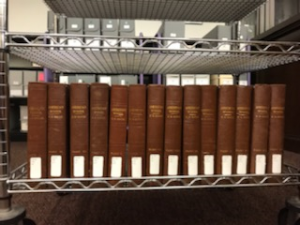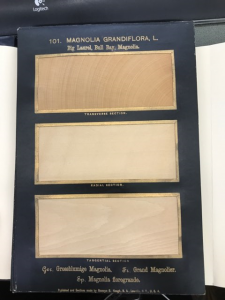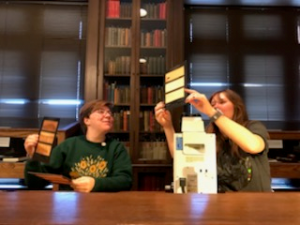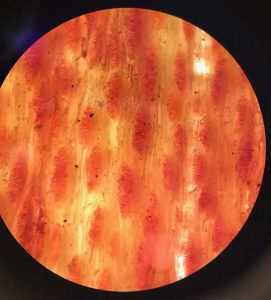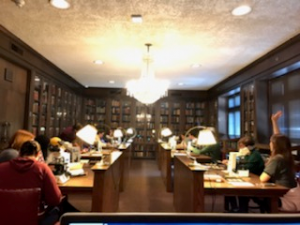This week we had some visitors in the Special Collections Department! On Wednesday, Dr. Levetin brought her Plant Anatomy class here to the Special Collections department to view “American Woods” by Romelyn Beck Hough. She’s been bringing this class to view this set for over twenty years! They bring some microscopes and pick a volume, using our collection to complete their assignment for the day.
Romelyn Hough’s father was Franklin B. Hough, who was the first chief of the United States Division of Forestry. He is sometimes referred to as “the father of modern forestry”, as he was one of the first to advocate for forest conservation. Romelyn inherited his father’s passion for trees and decided to catalog American tree species in the late 1800’s. To do this, he designed a tool that could cut wood slices very, very thin (1/1200 inch!). He collected transverse, radial, and tangential sections, then mounted them on slides and published them. The series consists of 1056 slices that represent 354 tree species. Each volume also contains a booklet, with dichotomous keys and descriptions of the different tree species represented in that volume.
The super thin slices that he was able to get out of trees made this series extra special because they are thin enough to see light through. This makes them invaluable for budding botanists, as it allows them to see tiny details under a microscope. I borrowed a scope and got to see a few myself. I just admired for aesthetics though. If you’re wondering what exact structures you’re looking at, then you should take a Plant Anatomy class sometime!
As you can imagine, a project like this can take a very long time to complete. The first volume was published in 1888 and sold for 5$ a piece. The fourteen volumes were released over a course of 25 years, with the last volume published posthumously by his daughter. Full sets are now hard to come by, as not very many people continued to purchase them through that 25 year period. Some other libraries have their volumes digitized and available for public use, but Dr. Levetin said that isn’t the same. Pictures of these slides don’t do this series justice, nor can they be viewed under a microscope. Better to make the short walk across campus and view the real thing!
We really enjoyed this class visit and look forward to more! Professors are always welcome to bring classes in to view any of our treasures. If you are unsure of what we have or want to talk more about what we can offer you or your class, feel free to stop by M-F 8:00-4:30, or send us an email as speccoll@ad.utulsa.edu. As always, individuals are also welcome anytime during those hours.

